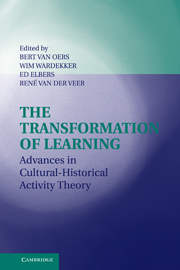Book contents
- Frontmatter
- Contents
- List of Contributors
- Preface
- INTRODUCTION
- SECTION ONE TENETS OF ACTIVITY THEORY
- Introduction to Section One: Exploring Vygotsky's Legacy: The Meaning of Mediation
- 2 Multiple Readings of Vygotsky
- 3 Exploring the Links between External and Internal Activity from a Cultural-Historical Perspective
- 4 Reflections on Points of Departure in the Development of Sociocultural and Activity Theory
- 5 Language in Cultural-Historical Perspective
- 6 The Formation Experiment in the Age of Hypermedia and Distance Learning
- 7 Constructivism and Meaning Construction
- 8 Subject, Subjectivity, and Development in Cultural-Historical Psychology
- SECTION TWO IDENTITY, DIVERSITY, AND INCLUSION
- SECTION THREE DYNAMICS OF ACTIVITY AND THE VARIATIONS OF LEARNING
- Index
- References
6 - The Formation Experiment in the Age of Hypermedia and Distance Learning
Published online by Cambridge University Press: 25 August 2009
- Frontmatter
- Contents
- List of Contributors
- Preface
- INTRODUCTION
- SECTION ONE TENETS OF ACTIVITY THEORY
- Introduction to Section One: Exploring Vygotsky's Legacy: The Meaning of Mediation
- 2 Multiple Readings of Vygotsky
- 3 Exploring the Links between External and Internal Activity from a Cultural-Historical Perspective
- 4 Reflections on Points of Departure in the Development of Sociocultural and Activity Theory
- 5 Language in Cultural-Historical Perspective
- 6 The Formation Experiment in the Age of Hypermedia and Distance Learning
- 7 Constructivism and Meaning Construction
- 8 Subject, Subjectivity, and Development in Cultural-Historical Psychology
- SECTION TWO IDENTITY, DIVERSITY, AND INCLUSION
- SECTION THREE DYNAMICS OF ACTIVITY AND THE VARIATIONS OF LEARNING
- Index
- References
Summary
It is well known that learning tasks and demands in science education present substantial difficulties for the majority of students (Aikenhead, 1994; Solomon & Aikenhead, 1994; Yager, 1996; see also Mikkilä-Erdmann 2001; Vosniadou et al. 2001; Wiser & Amin 2001). International comparisons (e.g., TIMSS – Third International Mathematics and Science Study, Martin & Kelly 1996; Baumert, Lehman, et al. 1997; and PISA – Programme for International Student Assessment, http://www.pisa.oecd.org, Baumert et al., 2001) reveal considerable problems concerning application tasks, problem solving, scientific argumentation, and the like, whereas reproductive tasks and skills are better mastered. In my view these results indicate that most of the students have tremendous problems in theoretical thinking. Science education suffers – among other shortcomings – from a predominant orientation toward isolated, nonsituated facts that are seldom applied to real-life situations, and this orientation leads to difficulties in understanding and a loss of sense and motivation in many students. One reason for this situation is the preference in today's classroom for an often unrelated, single-discipline approach as a means to interpretation and understanding. This approach is no longer viable, however, because mankind's problems are becoming more and more complex and their understanding and solution require the application of a transdisciplinary approach to address this complexity.
Mankind's problems are a consequence of developmental conflicts of complex systems (ecology, economy, climate, democracy). These systems are characterized by opposing tendencies.
- Type
- Chapter
- Information
- The Transformation of LearningAdvances in Cultural-Historical Activity Theory, pp. 100 - 126Publisher: Cambridge University PressPrint publication year: 2008
References
- 4
- Cited by



